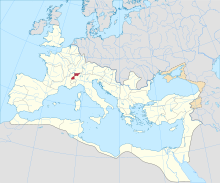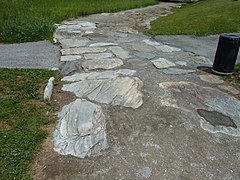Alpes Graiae et Poeninae
| Provincia Alpes Poeninae | |||||||
|---|---|---|---|---|---|---|---|
| Province of the Roman Empire | |||||||
| 15 BC–476 | |||||||
 The Roman Empire c. 125 AD, with the province of Alpes Poeninae highlighted | |||||||
| Capital | Darantasia/Octodurum | ||||||
| Historical era | Antiquity | ||||||
• Created by Augustus | 15 BC | ||||||
• Deposition of Romulus Augustulus | 476 | ||||||
| |||||||
| Today part of | |||||||
Alpes Poeninae [alˈpeːs ˈpoe̯nɪnae̯], also known as Alpes Graiae, was a small Alpine province of the Roman Empire, one of three such provinces in the western Alps between Italy and Gaul. It comprised the Val d'Aosta region (Italy) and the Canton Valais (Switzerland).
Its strongest indigenous tribe were the Salassi. Their territory was annexed by emperor Augustus in 15 BC. Its chief city was Augusta Praetoria Salassorum (Aosta).
Etymology
The province was named for poeninus mons, the Roman name of the Great St Bernard Pass. Near the pass was a sanctuary dedicated to Jupiter Poeninus.[1]
Because the name Poeninus is similar to Poenus (Latin for "Carthaginian"), some Roman authors inferred that the Carthaginian general Hannibal crossed this part of the Alps in his famous march on Italy in 218 BC, using either the Great St Bernard or Little St Bernard passes. The Roman historian Livy explains that Poeninus was actually a corruption of Penninus, the name of a deity worshipped by a local tribe. Livy adds that it was implausible that Hannibal took such a northerly route, as these high mountain passes would have been inaccessible at the time.[2] Tacitus mentions the Alpes Poeninae in connection with the movements of Otho.[3] Most historians agree, according to Polybius that Hannibal's army passed through the Alps via the region of the Segusii, and the pass known today as Montgenèvre.
History
After the region was conquered in 15 BC, it was incorporated into Raetia, a large district which stretched from the central Alps to the Danube. The population included a number of Celtic tribes, including the Nantuates and Seduni on the northern side of the St. Bernard Pass and the Salassi on the southern side.
By the time of Emperor Claudius (41-54 AD) the tribes were generally Romanized and the Vallis Poenina district was removed from the Raetia et Vindolicia province. Vallis Poenina included much of the valley north of the St. Bernard Pass. A new capital civitas was established near the ruins of Octodurus (civitas Vallensium now Martigny) and the residents enjoyed at least the protections of the Latin Rights. The Vallis Poenina district was merged with the Alpes Graiae or Alpes Atrectianae district to form the Alpes Graiae et Poeninae province.[4]
By the 3rd century AD there were several senator ranked families living in the province. Under the reforms of Diocletian, the province became part of the Diocese of Gaulliae. In 381, the first Bishop of the region, Theodul, was mentioned. After the Fall of the Western Roman Empire, the region was invaded by the Burgundians and incorporated into their kingdom. In 574 it was invaded by the Lombards and came under their authority. The Roman name and borders fell into disuse and by the Dark Ages it was part of Sapaudia.
Gallery
-
Amphitheater in Martigny
-
Roman road in Martigny
-
Traces of the amphitheater in Aosta
-
Aosta theater
-
Triumphal arch in Aosta
References
- ^ Wilkes, J.; S. Parker; R. Bagnall; W. Harris; A. Esmonde-Cleary; C. Wells; J. Drinkwater; R. Knapp; S. Mitchell; B. Z. Lund; R. Talbert; M. E. Downs; M. Joann McDaniel; J. Becker; S. Gillies; T. Elliott. "Places: 982257 (Alpes Graiae et Poeninae)". Pleiades. Retrieved November 1, 2014.
- ^ Livy XXI.38
- ^ Tac. Historiae 1.87.2 http://latin.packhum.org/loc/1351/4/86/93-101
- ^ Vallis Poenina in German, French and Italian in the online Historical Dictionary of Switzerland.
- Polybius - Istoriài - XXXIV.X
- States and territories established in the 1st century BC
- States and territories disestablished in the 5th century
- Provinces of the Roman Empire
- Tres Alpes
- Ancient Switzerland
- History of Aosta Valley
- Praetorian prefecture of Gaul
- 15 BC establishments
- 10s BC establishments in the Roman Empire
- 476 disestablishments
- 470s disestablishments in the Roman Empire






